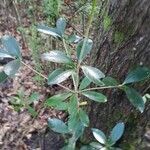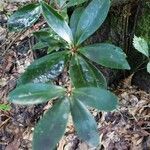Shrubs 1.5-10(-15) m tall. Bark grayish brown, smooth. Young branches grayish brown; current year branchlets purplish red to reddish brown, glabrous. Petiole 0.7-1.3 cm, glabrous, adaxially grooved; leaf blade obovate, oblong-obovate, or broadly elliptic, (3-)4-12 × 1.5-5.5 cm, leathery, abaxially pale green becoming reddish brown when dry, adaxially dark green and shiny, both surfaces glabrous, midvein abaxially elevated and adaxially impressed, secondary veins 5-7 on each side of midvein and obscure on both surfaces, base cuneate, margin entire or apically sparsely serrate, apex acute to shortly acuminate and with an obtuse tip. Flowers axillary, solitary or several clustered on leafless branchlets, 1-1.8 cm in diam. Pedicel 1-1.5 cm, recurved. Male flowers similar to bisexual flowers but ovary reduced to a pistillode. Bisexual flowers: bracteoles triangular to triangular-ovate, 1.5-2.5 mm, margin glandular dentate, apex acute; sepals ovate to long ovate, 4-7 × 3-4 mm, glabrous, margin glandular dentate, apex rounded; petals pale yellow, obovate, 6-9 × 4-6 mm, apex rounded and retuse; stamens 4-5 mm; anthers oblong, longer than filaments; ovary ovoid, 2-loculed with 2 ovules per locule; style 1-3 mm, apically 2-lobed. Fruit purplish red when mature, globose, 1-1.5 cm in diam., 2-loculed with 1 or 2 seeds per locule. Seeds reniform, ca. 6 × 4 mm. Fl. May-Jul, fr. Sep-Nov.
More
A shrub. It grows 2-10 m tall. The leaves are broadly oval and 4-12 cm long by 2-6 cm wide. They are pale green underneath. The flowers can occur singly in the axils of leaves or as several in clusters on leafless branches. They are 1-2 cm across. The petals are pale yellow. The fruit is purplish red when mature. They are round and 1.5 cm across. There are 2 locules and 1 or 2 seeds in each.


